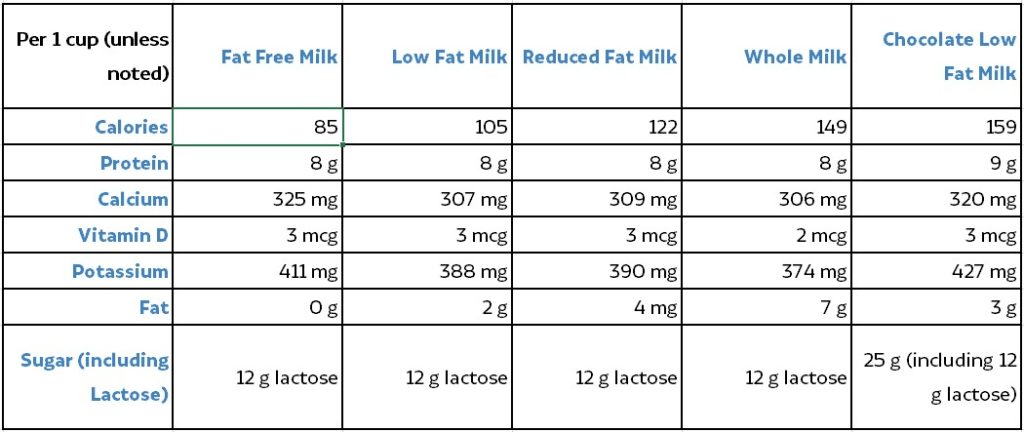Milk provides a unique combination of nutrients to American diets. Milk contains thirteen essential nutrients[i], including three of the four nutrients identified as dietary components of public health concern in the 2020-2025 Dietary Guidelines for Americans (DGA)—calcium, vitamin D and potassium.[ii] Milk provides 22% of the calcium, 40% of the vitamin D and 10% of the potassium in the American diet.[iii] In addition to these nutrients, milk is also a good source of protein, vitamin A and B vitamins, combining into a nutrient package not found in other foods or beverages.
The unique composition of dairy can lead to distinctive health impacts. For example, in a recent study, milk is highly hydrating due to its combination of macronutrients and electrolytes.[iv]
Milk with lower lactose provides the same important package of nutrients as conventional milk, meaning that it is an important nutrient-dense beverage for those with lactose intolerance. The 2020-2025 DGA recommend that Americans who are lactose intolerant can choose low-lactose or lactose-free dairy products to meet their recommended dairy intake. If people avoid dairy completely due to concerns about lactose intolerance, this can adversely affect their intake of calcium, potassium, and vitamin D -- nutrients already lacking in the American diet.[v]
Flavored milks provide the same 13 essential nutrients as unflavored milk. including calcium, vitamin D and potassium.[vi] Even with a lower consumption than with unflavored milk, flavored milk provides 2% of the calcium and 5% of the vitamin D in the American diet.[vii]
Flavored milk contributes only 4% of total added sugar per capita. The moderate levels of added sugars in these products increase palatability, thereby encouraging Americans to consume these nutrient-dense foods. Flavored dairy products contain the same nutrients as their unsweetened counterparts, but with some added sweetener ingredients that can provide a flavor that some consumers prefer or that provide other functional purposes.
Children who consume flavored milk drink more milk overall and have higher intakes of vitamins D, A, calcium, potassium and other nutrients than children who don't drink flavored milk.
Whole milk contains the same nutrients as all other fluid milk, including calcium, phosphorus, protein, vitamins A, D and B12, pantothenic acid, riboflavin, and niacin. Recent research has shown that there is no harm, and some potential benefits of full fat dairy foods[viii] such as whole milk, including less weight gain[ix] andneutral or lower risk of heart disease[x].
Reduced or fat-free milk offers comparable nutrient levels to whole fat milk aside from the lower levels of fat as shown in this chart:

In addition to providing a variety of important nutrients on its own, milk is also a key component of an overall healthy diet. The 2020-2025 DGA recommended three daily servings of milk or other dairy foods in the Healthy US and Vegetarian meal patterns for Americans 9 and older. The DGA also included lowfat and fat free milk as part of the recommended dietary pattern to promote good health.
But the DGA also shows that 90% of Americans don’t consume enough dairy—adding a serving of milk each day will help close that gap and provide more essential nutrients.
[i] USDA FoodData Central online at https://fdc.nal.usda.gov/. Mean values calculated from database entries across all fat levels of plain vitamin D-fortified fluid milk in Legacy, Foundation, and Survey (FNDDS) data sources. Based on the 2019 DRI for potassium developed by NASEM
[ii] U.S. Department of Agriculture and U.S. Department of Health and Human Service. Dietary Guidelines for Americans, 2020-2025. 9th Edition. December 2020. Available at DietaryGuidelines.gov.
[iii] National Dairy Council. NHANES 2011-2014. Data Source: Centers for Disease Control and Prevention, National Center for Health Statistics, National Health and Nutrition Examination Survey Data, Hyattsville, MD: U.S. Department of Health and Human Services.
[iv] Ronald J Maughan, Phillip Watson, Philip AA Cordery, Neil P Walsh, Samuel J Oliver, Alberto Dolci, Nidia Rodriguez-Sanchez, Stuart DR Galloway, A randomized trial to assess the potential of different beverages to affect hydration status: development of a beverage hydration index, The American Journal of Clinical Nutrition, Volume 103, Issue 3, March 2016, Pages 717–723, https://doi.org/10.3945/ajcn.115.114769
[v] Savaiano DA, Boushey CJ, McCabe GP. Lactose intolerance symptoms assessed by meta-analysis: a grain of truth that leads to exaggeration. J Nutr. Apr 2006;136(4):1107-1113
[vi] USDA FoodData Central online at https://fdc.nal.usda.gov/. Survey Data for Food Codes: 11511400. Based on the 2019 DRI for potassium developed by NASEM
[vii] National Dairy Council. NHANES 2011-2014. Data Source: Centers for Disease Control and Prevention, National Center for Health Statistics, National Health and Nutrition Examination Survey Data, Hyattsville, MD: U.S. Department of Health and Human Services
[viii] Mozaffarian D. Dietary and Policy Priorities for Cardiovascular Disease, Diabetes, and Obesity: A Comprehensive Review. Circulation 2016; 133: 187-225
[ix] Rautiainen S, et al. Dairy consumption in association with weight change and risk of becoming overweight or obese in middle-aged and older women: a prospective cohort study. Am J Clin Nutr 2016 Apr;103(4):979-88.
[x] Lordan R, A Tsoupras, B Mitra, I Zabetakis. Dairy fats and cardiovascular disease: do we really need to be concerned? Foods 2018:7, 29.
Guo J et al. Milk and dairy consumption and risk of cardiovascular diseases and all-cause mortality: dose-response meta-analysis of prospective cohort studies. Eur J Epidemiol 2017 32(4): 269-287.